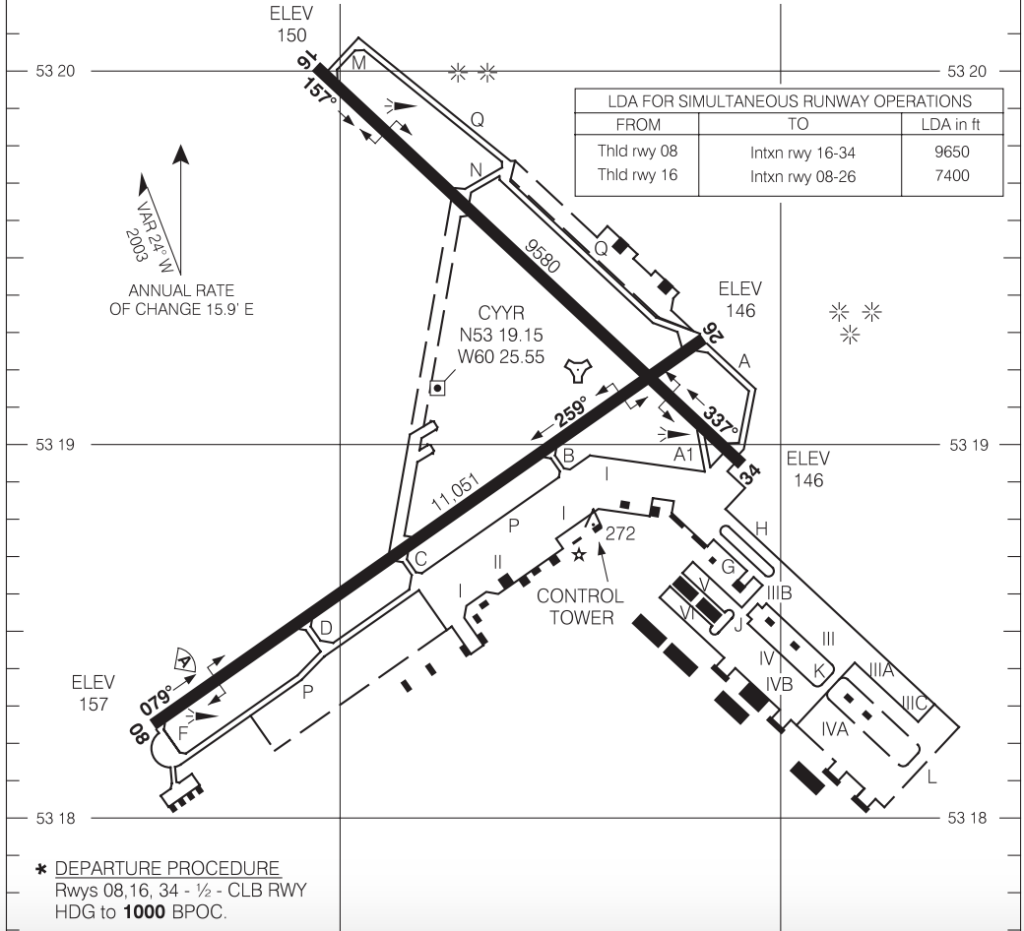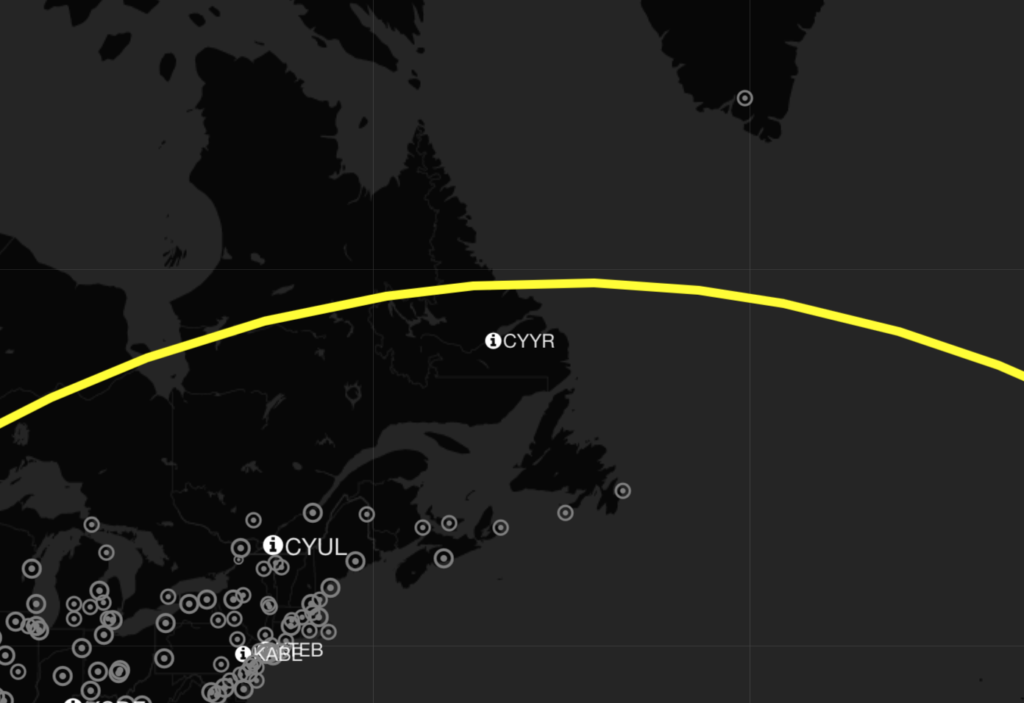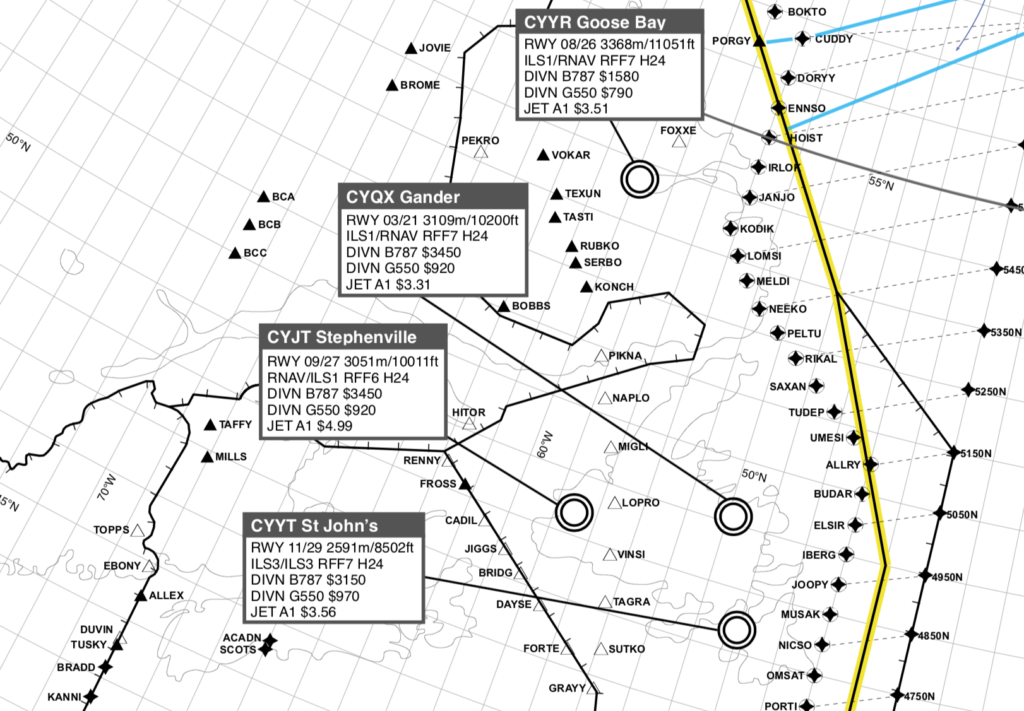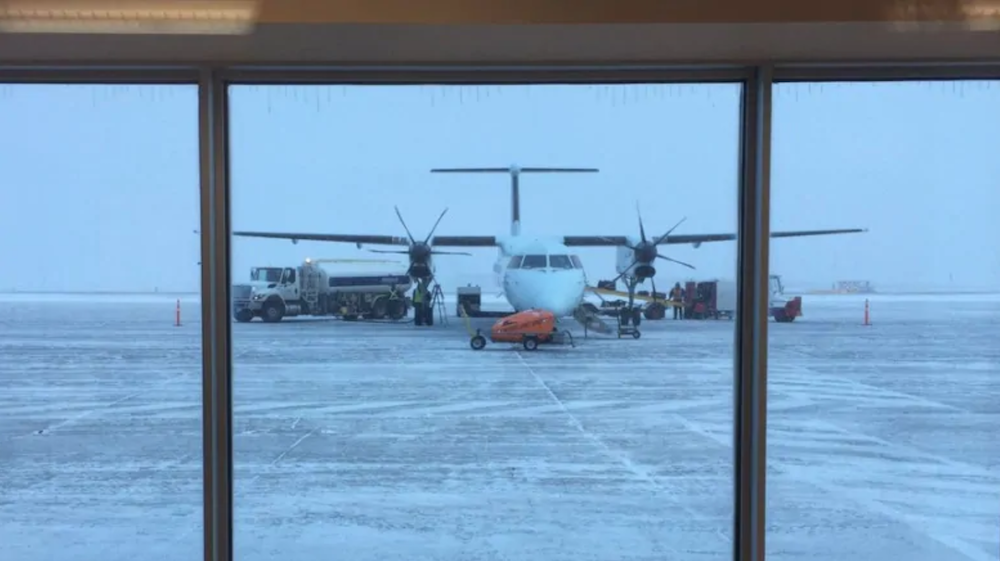Larger jets will not be allowed to land on three out of four runways at Goose Bay for the next three months, as they’ve found cracks after the winter thaw.
The airport has settled on a final version of their “Our runway is broken” Notam, and it looks like this:
05/037 – CYYR RWY 08, 26 AND 34 NOT AVBL FOR ACFT WITH TIRE PRESSURE OF 1.0MPA (145 PSI) OR GREATER AND ACFT WITH ACN/PCN OF 40 OR GREATER, EXC MEDEVAC AND AVBL AS EXTENDED RANGE TWIN-ENGINE OPS (ETOPS) ALTERNATE.
21 MAY 14:01 2019 UNTIL 17 AUG 23:59 2019. CREATED: 21 MAY 14:06 2019
So not the most pilot-friendly piece of information! Unless you happen to know your tire pressure off-hand, best head for RWY 16, which is the only one that remains fully open and operational to all aircraft (the only reason RWY 34 is restricted is because aircraft using that runway touch-down on the intersection with RWY 08/26 – which is where some of the cracking damage has been found).

The Notam does state that the other three runways at CYYR can still be used an ETOPS alternate, meaning that you’re allowed to divert there in an emergency regardless of size, weight, tire pressure, or ACN. However, with the deteriorating runway conditions they’re also warning of possible aircraft damage due to loose sealant and asphalt:
05/038 (190206) – CYYR RWY 08/26 SFC IS DETERIORATING AND CRACKING AND MAY PRODUCE FOREIGN OBJECT DEBRIS (LOOSE SEALANT AND ASPHALT) ACFT DAMAGE MAY OCCUR. 23 MAY 18:20 2019 UNTIL 23 AUG 23:59 2019. CREATED: 23 MAY 18:24 2019
ACN vs PCN
The mention of “ACN/PCN” in Goose Bay’s Notam made us close our eyes and try to imagine a world where Notams just made immediate sense.
Knowing your tire pressure is one thing, but trying to work out your ACN number is a much more tricky business, as it has to factor in the aircraft’s maximum centre of gravity, maximum ramp weight, wheel spacing, tire pressure, and other factors. Your AFM should have a bunch of pages which tell you this (or you can have a quick look here instead).
Once you know your ACN number (or rather, ‘numbers’ – as there are different ACN numbers for each aircraft depending on the strength of the runway you’ll be landing on), you can then check it against the runway PCN number – the number issued for each runway which tells you what kind of surface it is, how strong it is, and what level of stress it is able to withstand.
Ultimately, if your aircraft’s ACN is equal to or less than the runway’s PCN, you’re good to go.
In the AIP, Goose Bay’s runway PCN is 076FBXU. The important bits here:
- the PCN number here is 76
- the F means that the runway is ‘Flexible’ (i.e. made of asphalt rather than concrete)
- the B means it is of ‘Medium’ strength
- the X means it has maximum tire pressure of 1.75 MPa.
So, under normal circumstances, CYYR has a runway PCN of 76, meaning most aircraft would be able to operate here:
| Aircraft | Tire Pressure (MPa) | Pavement grades | |||
|---|---|---|---|---|---|
| High | Med | Low | Very low | ||
| A | B | C | D | ||
| A330-300 | 1.42 | 62 | 68 | 79 | 107 |
| B737-800 | 1.47 | 44 | 46 | 51 | 56 |
| B787-800 | 1.57 | 60 | 66 | 81 | 106 |
| Bombardier BD-700, Global Express, XRS | 1.15 | 26 | 28 | 31 | 32 |
| Bombardier Challenger CL 600, 601, 604 | 1.21 | 12 | 13 | 15 | 16 |
| Dassault Falcon | 1.36 | 9 | 10 | 11 | 12 |
| Embraer 190, 195 | 1.1 | 28 | 30 | 33 | 35 |
| Gulfstream II | 1.04 | 17 | 18 | 20 | 22 |
| Gulfstream V | 1.37 | 26 | 28 | 30 | 31 |
| Learjet 24F (Bombardier) | 0.79 | 3 | 3 | 4 | 4 |
| Learjet 60 (Bombardier) | 1.48 | 6 | 7 | 7 | 8 |
But with all the runway cracking that’s been going on, Goose Bay’s PCN number is no longer accurate. It’s probably safer to assume the B is more like a D right now – runway strength ‘Very low’. And the new CYYR Notam suggests the new PCN number is 40 (as aircraft with an ACN number higher than that are not allowed to go there).
Other NAT alternates?
A quick check on GoCrow shows us there’s really nothing available to the north of CYYR:

But there are some decent options to the south:

This isn’t the first time Goose Bay has had problems with its runways. In Nov 2017, the airport was closed due to ‘sticky’ runways – during snow removal crack sealant was found on vehicles after they were used on the runways.
Further reading:
- United Airlines has downgraded Goose Bay Airport’s suitability for diversions, after one of its flights with 250 passengers on board diverted there on 19th Jan 2019, and was then forced to spend 16 hours on the ground as there were not enough customs staff available to process everyone on board to enter Canada. Customs opening hours at the airport are 8am to midnight daily.
More on the topic:
- More: What’s Changing on the North Atlantic
- More: Timeline of North Atlantic Changes
- More: Spoofed Before the NAT? Here’s What to Do
- More: Shanwick Delays OCR Until Post-Summer 2026
- More: Blue Spruce Routes Are Gone (But You Can Still Fly Them)
More reading:
- Latest: Mexico Customs Surprises: Pills, Vapes, and Laptop Rules
- Latest: Greenland NAT Alternates: Dec 2025 Update
- Latest: Crossing the Quiet South: From Australia to Argentina
- Safe Airspace: Risk Database
- Weekly Ops Bulletin: Subscribe
- Membership plans: Why join OPSGROUP?











 Get the famous weekly
Get the famous weekly 





